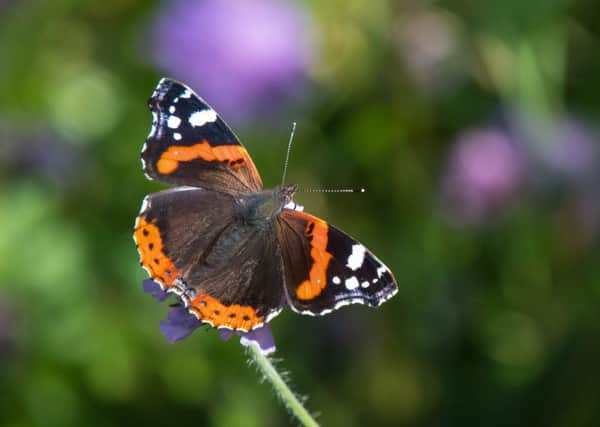Red Admiral thrives despite wet weather


The Red Admiral saw its numbers rise by 223 per cent compared to 2016, during the Count’s three-week recording period.
But wet summer weather meant that 2017 was not a vintage year with many of Scotland’s most widespread species of butterfly experiencing declines.
Advertisement
Hide AdAdvertisement
Hide AdThe admiral boom was helped by a good year in 2016 followed by a mild winter and warm spring this year.
Red Admirals that had overwintered in the UK and fresh immigrants arriving in spring from southern Europe enjoyed an early and successful breeding season giving rise to a bumper summer brood.
Despite the Red Admiral’s comeback it was the Small White which was the most commonly seen species in Scotland with 2,016 counted in total, a 13% increase on last year’s result.
A record 60,000 participants took part in the Count across the UK, the world’s largest butterfly survey, counting more than 550,000 individual butterflies during the three week, high-summer recording period,
Advertisement
Hide AdAdvertisement
Hide AdOther winners include the distinctive Comma which benefited from the warm spring by producing a strong summer generation. This species has rapidly colonised Scotland since the millennium and is now seen as far north as Aberdeen and Inverness.
Numbers of the Peacock increased by 89 per cent compared to last summer’s Count and the Large White experienced a rise of 12 per cent rise on 2016.
But many of Scotland’s most common butterflies declined with the Green-veined White down 54 per cent and the Ringlet down 49 per cent during the Count period in high summer. The Meadow Brown, Speckled Wood and Common Blue all saw numbers tumble by 44 per cent, 35 per cent and 18 per cent respectively.
A mild winter and warm spring meant some species emerged earlier than normal so that some were already past their peak numbers by the time of the Count. The very wet summer then had a negative impact on the numbers of butterflies being seen.
Advertisement
Hide AdAdvertisement
Hide AdParticipants in Scotland recorded the lowest number of individuals spotted per-count since the scheme began, with an average of just six butterflies seen.
Richard Fox, Butterfly Conservation’s head of recording, said: “It hasn’t been a vintage summer for butterflies, but there have been some real positives.
“Above all, the highlight of Big Butterfly Count 2017 has been the huge number of people that have got involved, spent time enjoying and counting our native butterflies and moths and done something useful and important in the face of so much wildlife decline.”
Results from the Big Butterfly Count help Butterfly Conservation to find out how the UK’s common species are faring and how to best protect them in the future.
Advertisement
Hide AdAdvertisement
Hide AdMore than three-quarters of the UK’s butterflies have declined in the last 40 years with some common species, such as the Small Tortoiseshell, suffering significant slumps.
The Big Butterfly Count is sponsored by Waitrose.
Tor Harris, head of sustainability and responsible sourcing said: “We’re really happy our support of the Big Butterfly Count has helped such a large number of people get involved in wildlife research.
“The environment is important to all of us so we’re thankful to everyone who took part to produce the results.”
Results can be found at www.bigbutterflycount.org.
Big Butterfly Count 2017 – top 10 species ranking in Scotland
1. Small White 2016 seen
2. Green-veined White 1362
3. Ringlet 1322
4. Small Tortoiseshell 967
5. Meadow Brown 876
6. Large White 810
7. Red Admiral 798
8. Six-spot Burnet 770
9. Speckled Wood 639
10. Common Blue 548